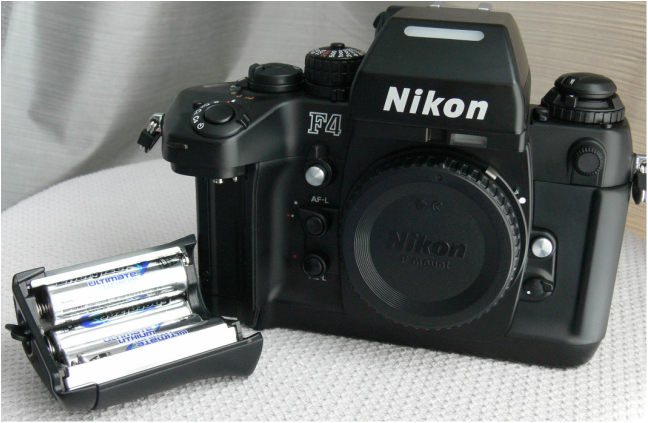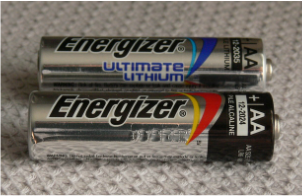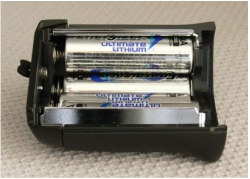 Nikon F4 w/ MB-20 Grip Loaded with Lithiums Nikon F4 w/ MB-20 Grip Loaded with Lithiums Updated June 11, 2022 Google the above question and be prepared for a merry-go-round of answers and opinions across forums and blogs. It is not the intent of this article to find fault with anyone or incite riots ;-). It is, hopefully, to provide some clarity, which is not so easy, seeing as Nikon itself changed its position from "NO, ABSOLUTELY NOT!!", and "DO IT AT YOUR OWN RISK. WE are NOT responsible for any damage that may occur"...to "alright, it's okay, if you must". Logically, this raises doubts and questions, questions that I wondered about when I purchased my own F4. Why did Nikon change its position? What, if any, risk would I be taking by using lithiums in mine? This article is the result of my investigation of this issue. The conclusion I came to may or may not sound reasonable to you. I hope it will be of some help to someone :-).  Lithium vs. Alkaline Lithium vs. Alkaline Nikon and the Winds of Change To start, let's go back to the introduction of lithium iron-disulfide AA cells in 1988 (coincidentally the same year the F4 came out) at Photokina, the international photo show held every two years in Germany. Eveready Battery Company (today Energizer) was claiming to have developed a lithium AA battery that was directly interchangeable with alkalines. Why this was considered a big deal was that, traditionally, a lithium manganese dioxide cell has a 3V output whereas an alkaline is 1.5V. So to make a lithium battery with the same footprint as an alkaline but with half the output of the traditional type took some serious engineering. The advantages of lithiums over alkalines are: less weight, a flatter discharge curve, longer life in high-drain devices, far longer shelf-life, being far less prone to leakage, and they give far superior cold-weather performance. All of this for a price...about 2.5 to 5 times the price of alkalines (you can buy Ultimate Lithiums in a bulk pack of 12 in some parts of the world now, which is the most economical way to do it)! Now, the batteries did not become available for consumers until 1992. Nevertheless, photographers were excited, including F4 owners. But then...Nikon...(and to be fair, other manufacturers) came out and said "Wait a minute, we cannot recommend this product for use with our products...damage may result...yadda, yadda, yadda..." Which is the same line these manufacturers have used for decades about third-party lenses, flashes, and other accessories (trying to protect their own sales of such items;-)). Was that the case here? Herbert Keppler, long-time editor of Modern, and later, Popular Photography, was curious, so he wrote to Eveready to find some answers. They wrote back to him and he reprinted their reply in its near-entirety in his SLR column in the February 1994 issue of Popular Photography, pp. 26-28. Pertinent sections of that reply are quoted here: ...Several photographic manufacturers have raised an issue following the introduction of the L91 (the model # of the AA lithium). These manufacturers are concerned about the use of the L91 in photography equipment. Some manufacturers have recommended to their dealers that the L91 NOT be used in their equipment. These manufacturers' warnings are based on theoretical (italics mine) concerns related to a higher initial open-circuit voltage and under load closed-circuit voltage on the L91 battery. The manufacturers' general concern is that this voltage may damage the circuitry of their cameras or photo flash units or tear the perforations in the film under very low temperature conditions. It is this issue of higher initial open circuit and under load closed circuit voltage that is sometimes raised in forums, with claims being made that it will fry an F4. Eveready continues: Dr. William M. Miller, Manager, Reliability Physics, Sandia National Laboratories, has written to Eveready summarizing the effect of overvoltage on integrated circuits. He states, 'In conclusion, when ICs of good quality are used, a 14 percent voltage increase due to the new Eveready battery (L91) should not pose a threat to these ICs.' Then comes a very significant statement: We believe these concerns are really very much of a timing issue. The manufacturers had not been testing the batteries in large numbers. However, when the product was introduced to the market and was quickly accepted by consumers, they became concerned with 'potential' issues which needed further study. They have therefore issued warnings to protect themselves against these 'potential' concerns. (Italics and underlining mine) Aha! Now we are getting somewhere! One can sense a teeny bit of irritation from Eveready with "potential" being used twice in the same paragraph. Amongst the big camera manufacturers Nikon had long been considered the most conservative. They were loath to take shortcuts in product development (not necessarily the case anymore). There was resistance among Nikon engineers when it came to lithiums vs. alkalines in normal (well above freezing) temperatures. So thorough testing of the new Evereadys was not high on their priority list. How did things proceed? Returning to the Eveready letter: The manufacturers are now testing large samples of the L91 in their products. We do not anticipate any significant problems will be found. (Italics Eveready's) Testing has been done in the USA by targeted professional photographers with excellent results. One of the professional photographers who tested lithiums in the F4 as well as other Nikon models like the N90s (F90X), was Galen Rowell, who wrote this in his April 1996 Outdoor Photographer column: ...My battery problems were solved by using Energizer lithium AAs in my N90s. Nikon recently dropped their earlier recommendation not to use these slightly higher voltage units in their electronic cameras after encountering no problems during several years of informal trials. Energizer lithium AAs cost much more, but weigh 40 percent less, work below 0 degrees Fahrenheit, and last at least three times as long in low temperatures. (Bold, italics, and underlining mine)  The MB-20 w/ Lithiums The MB-20 w/ Lithiums So there you have it. By 1996 Nikon had changed its position on lithium AA battery use in its products after several years of testing. And by 2001, they were even listing L91/FR6 specifications with the F90x/N90s for dealers that showed 5 times the lifespan of alkaline AAs at room temperature and 14 times at -10 degrees C. They didn't make a lot of noise about it, however, and so didn't do much to clear up the confusion, which persists even today. It was the efforts of photographers like Galen Rowell, whose favored F4 configuration was an MB-20 grip with 4 lithium AAs nestled inside, that eventually convinced Nikon that Lithiums were OK. Alright, so Nikon changed their position, grudgingly, when faced with several years worth of informal testing that proved their fears of "potential" issues to be unfounded. But does that mean that there is no risk to your camera if you use lithium AAs?
In our lab we were able to increase the sequence rate from a tested 5.68 (very close to the 5.7 rating of Nikon) to 9 frames per second by using a regulated external power supply and gently bringing the voltage up to 12, rather than using the standard 9-volt output from 6 AA cells. There was no apparent deleterious effect on the camera. Nikon obviously did not endorse PP's approach (don't you wish cameras were still tested like this? :-)) of overboosting the F4 by 33%, so why did they do it? Lithium manganese batteries (the traditional 3-volt cell type) were all the rage in the late '80's. Photography writers were in love with their high power-to-weight ratio and longevity compared to alkalines and rechargeables of the day. And the manufacturers were already changing many of their fancy new power-hungry auto focus SLRs over to these types of batteries in two-cell 6V configurations. What the PP staffers were hoping for was that Nikon was going to offer a 12-volt (4 - 3V cells) lithium-powered version of the F4S (making it lighter and the grip more compact & as a bonus, shoot at 9 fps) in the future. So, in their curiosity, they tested the camera at 12V to see if the margins that Nikon had built into it would make their wish feasible. Nikon did not have that eventuality in mind at all, and told PP that running the F4S at that rate could create other timing problems (bet they didn't see that one coming ;-)). A perhaps unintended side effect was demonstrating that the F4 had been built with a fairly hefty margin of safety in its electronics (as it should have been). So if you have an F4S (with the MB-21) or an F4E (with the MB-23) should you push it with lithiums? That is a tougher decision than with the standard F4, as it definitely will run you closer to the margins. Remember this important fact though, the 17% overvoltage lasts for 2 milliseconds and then drops to less than 9.4V. So it's not like the camera is 17% overboosted all of the time. It would be more like 0.2% of the time. This is not being stated to pressure anyone into using lithiums in these cameras, it is just about trying to provide as much information as possible so you can make an informed decision, not one based on hearsay and supposition. It is notable that many F4S & E owners testify that they have used lithiums for years with no problems whatsoever. I have not been able to find a single documented case of lithiums being responsible for the destruction of an F4 (or any other camera, for that matter). That doesn't necessarily mean that there aren't any examples, it just means I haven't found one yet. It also does not mean that if you choose to use lithiums, you will never have an electrical problem with an F4. Any electronic device can fail, even when all possible precautions are taken. And there are myriads of ways in which it can fail. These cameras are a minimum of 25 years old now, so the possiblilty of electronic failure should be kept in mind when thinking of purchasing one, even though they are one of the most reliable cameras ever made and they are a steal value-wise. You need to go with what makes you feel comfortable. After all, it's your camera. It's not for me or anyone else to make up your mind about risk. So let's say you are willing to accept the risk. What do lithiums get you? The biggest reasons for using lithiums are summed up in Galen Rowell's comments from earlier: less weight, superior cold-weather performance (14x the lifespan of alkalines at -10 C), and five times the longevity of alkalines at room temperature. Rowell was in the mountains constantly, where those 3 things were his top priorities. And they continue to be the greatest advantages of lithiums. And it is with the plain F4, and its smaller MB-20 grip, that these advantages are most keenly felt. References: Popular Photography Nov. 1992, p. 16 @ Google Books Popular Photography Feb. 1994, pp. 26-28 @ Google Books Charging Personal Batteries by Galen Rowell, Outdoor Life, April 1996 Popular Photography June 1989 p. 48 @ Google Books Cylindrical Primary Lithium Handbook & Application Manual @ data.energizer.com Energizer L91 Product Datasheet @ data.energizer.com
8 Comments
10/4/2016 12:01:50 am
Thanks for sharing information about lithium battery. Keep sharing this type of informative blog.
Reply
C.J. Odenbach
10/4/2016 06:23:48 am
Thanks for the feedback! Love the F4. Glad to hear from you :-)
Reply
JM Hernandez
5/15/2018 04:33:45 pm
I really appreciate this detailed information.
Reply
C.J. Odenbach
5/15/2018 04:50:04 pm
Thanks for taking the time to comment, JM. Happy shooting!
Reply
Dim
3/22/2020 08:11:12 pm
Hello thank you so much for such incredible information! I am so grateful to find it. I was thinking how to permanently increase the power of Nikon F4 and I found out that you can take a 9V battery and open it. Inside there are tiny batteries 1.5V each which you can take 2 and stick together but each of them should be placed longer than the other in order to touch contacts of the device. Moreover when you stick such 2 tiny batteries you need to peel skin a bit so it would be linked together... you can find on internet how to double AA battery . So basically you can insert 7 or even 8 batteries inside F4 . 7 batteries 1.5V will give 10.5V and 8 batteries 12V... I am scared to use 8 batteries but 7 batteries seems ok. Do you think it’s dangerous to use 7 batteries and running Nikon F4 at 10.5V all the time ? The autofocus will be faster so focus tracking will be amazing . I can’t image how good it will be at 12V ... Can it be same as F5 or even better ?
Reply
C.J. Odenbach
3/22/2020 11:17:23 pm
Hi Dim,
Reply
As of Jan 2024, the current voltage rating for Energizer Ultimate Lithium AA batteries is L91 is 1.5 volts, so the voltage is equal to that of Alkaline AA cells.
Reply
C.J. Odenbach
1/25/2024 08:02:17 am
Thanks for the updated data sheet Gregory. The nominal voltage rating provided by Energizer has always been 1.5V because that is where the battery sits almost after the initial 1.8V reading. The discharge graphs below the specifications on the data sheet have remained unchanged and show the rapid drop from 1.8V to 1.5V. Thank you for taking the time to share and make sure that the article remains up to date.
Reply
Your comment will be posted after it is approved.
Leave a Reply. |
C.J. OdenbachSuffers from a quarter-century and counting film and manual focus SLR addiction. Has recently expanded into 1980's AF point and shoots, and (gack!) '90s SLRs. He even mixes in some digital. Definitely a sick man. Categories
All
Archives
June 2024
|
 RSS Feed
RSS Feed